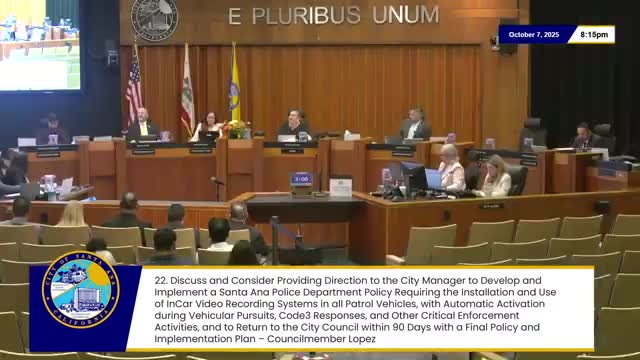Santa Ana to study dash and in-vehicle camera systems for patrol cars; staff to report in January
October 08, 2025 | Santa Ana , Orange County, California
This article was created by AI summarizing key points discussed. AI makes mistakes, so for full details and context, please refer to the video of the full meeting. Please report any errors so we can fix them. Report an error »

Santa Ana councilmembers on Tuesday asked city staff and the police chief to produce a detailed report on dashboard and in-vehicle camera systems for patrol cars and to return in the first council meeting in January with cost estimates and implementation options.
The discussion followed a council motion to evaluate adding vehicle-mounted forward-facing cameras and other vehicle video systems that would supplement officers’ body-worn cameras. Police representatives said body cameras remain the department’s cornerstone of accountability but that vehicle systems capture the vehicle’s exterior vantage point and can be configured in different ways.
“Body camera activation can take about 30 seconds; dash and vehicle systems capture views the officer may not see, and different vendors offer forward-facing dash cameras, 360-degree roof-mounted units and interior-cabin cameras,” the chief said during the discussion (timecode 8532–8585). Staff told council there are roughly 50–60 patrol vehicles to consider outfitting, and that vehicle systems require infrastructure for cloud storage and retention — an expense that varies substantially by vendor and retention policy.
Councilmembers from several districts supported studying the equipment and costs. Councilmember Peñaloza and others asked staff to include comparisons to other agencies, purchase and installation costs, whether interior-cabin recording is lawful and appropriate, storage and retention costs, and possible funding sources. The police chief confirmed dash systems typically record the street-facing view; interior cabin recording is a separate system and raises additional data-retention and privacy considerations.
No contract was approved at the meeting. Staff was directed to bring back a full report including vendor options, number of vehicles to equip, estimated capital and ongoing cloud storage costs and recommended policy controls on retention and access by the January council meeting.
Why it matters: Vehicle cameras can provide additional evidence in incidents involving patrol vehicles and offer a different viewpoint than body cameras, but they raise questions about cost, retention and privacy.
What’s next: Staff to prepare the comparative study, cost estimate and implementation plan and return to the council in January.
The discussion followed a council motion to evaluate adding vehicle-mounted forward-facing cameras and other vehicle video systems that would supplement officers’ body-worn cameras. Police representatives said body cameras remain the department’s cornerstone of accountability but that vehicle systems capture the vehicle’s exterior vantage point and can be configured in different ways.
“Body camera activation can take about 30 seconds; dash and vehicle systems capture views the officer may not see, and different vendors offer forward-facing dash cameras, 360-degree roof-mounted units and interior-cabin cameras,” the chief said during the discussion (timecode 8532–8585). Staff told council there are roughly 50–60 patrol vehicles to consider outfitting, and that vehicle systems require infrastructure for cloud storage and retention — an expense that varies substantially by vendor and retention policy.
Councilmembers from several districts supported studying the equipment and costs. Councilmember Peñaloza and others asked staff to include comparisons to other agencies, purchase and installation costs, whether interior-cabin recording is lawful and appropriate, storage and retention costs, and possible funding sources. The police chief confirmed dash systems typically record the street-facing view; interior cabin recording is a separate system and raises additional data-retention and privacy considerations.
No contract was approved at the meeting. Staff was directed to bring back a full report including vendor options, number of vehicles to equip, estimated capital and ongoing cloud storage costs and recommended policy controls on retention and access by the January council meeting.
Why it matters: Vehicle cameras can provide additional evidence in incidents involving patrol vehicles and offer a different viewpoint than body cameras, but they raise questions about cost, retention and privacy.
What’s next: Staff to prepare the comparative study, cost estimate and implementation plan and return to the council in January.
View full meeting
This article is based on a recent meeting—watch the full video and explore the complete transcript for deeper insights into the discussion.
View full meeting
